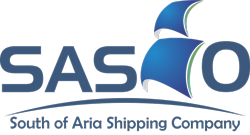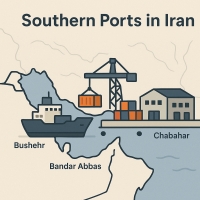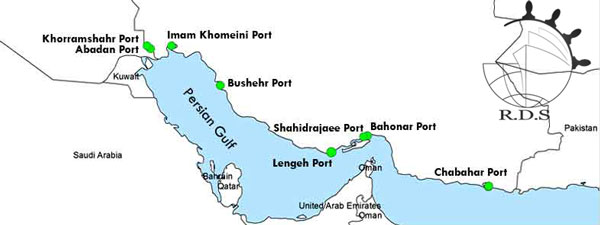Port of Shahid Rajaee: Iran’s Premier Cargo Hub
The Port of Shahid Rajaee, located 23 km west of Bandar Abbas in Hormozgan Province, Iran, is the country’s largest port and the main southern port in Iran, handling over 80% of the country’s container traffic. Situated along the Strait of Hormuz, it spans 2,400 hectares with 40 berths (up to 15m depth) and can process 6 million TEUs of containers. Equipped with 30 gantry cranes, it supports large vessels and offers 19 hectares of warehouses, a grain silo, and terminals for containers, bulk, and oil cargo. As a Special Economic Zone, it handles 55% of Iran’s non-oil trade and 70% of containerized cargo, connecting to rail, road, and the North-South Transport Corridor.
Main Cargo Routes
As a southern port in Iran, Shahid Rajaee Port in Iran links to over 80 global ports, serving East Asia (China, Singapore), Europe (Mediterranean, Northern Europe), and the Middle East (UAE, Qatar). It is a key node in the North-South Corridor, facilitating transit to Central Asia and Europe via Russia.
Port of (Bandar) Imam Khomeini: Strategic Gateway for Bulk Cargo
Located on the northwestern coast of the Persian Gulf, Bandar Imam Khomeini is one of the main southern ports in Iran and a key maritime and logistics center in Khuzestan Province. Situated near Musa Bay, approximately 100 kilometers east of Abadan and 175 kilometers southeast of Ahvaz, the port benefits from a natural waterway — Khor Musa — which allows vessels of up to 100,000 tons to access its facilities without the need for dredging. This natural advantage distinguishes it among the list of ports of Iran. The port covers a wide operational area with seven terminals and 40 berths along a 6,500-meter quay front. It also includes over 287,000 square meters of sheltered warehouses and nearly 11 million square meters of open storage space.
This important southern port in Iran, located at the head of the Persian Gulf, is a key facility for bulk cargo, particularly grains, petrochemicals, and oil products.
Main Cargo Routes
Bandar Imam Khomeini is integrated into Iran’s national transport network. It lies at the southern end of the Trans-Iranian Railway, connecting the Persian Gulf to Tehran, the Caspian Sea, and northern trade corridors. By road and rail, it links to major Iranian cities and borders — including Abadan, Khorramshahr, Ahvaz, Tehran, and even beyond to the Caucasus region. This strategic location enhances its role among the most connected southern Iran ports.
Port of Chabahar: Iran’s Only Oceanic Port
The Port of Chabahar, in one of the other southern ports in Iran, located on the southeastern coast of Iran along the Gulf of Oman, stands as Iran’s only oceanic port. Situated roughly 170 kilometers west of Pakistan’s Gwadar Port, Chabahar occupies a pivotal place on the list of ports of Iran. The port consists of two separate terminals—Shahid Kalantari and Shahid Beheshti—each with five berths, and forms a vital hub in regional connectivity between South Asia, Central Asia, and the Middle East.
The current handling capacity of Chabahar Port is approximately 100,000 TEUs (twenty-foot equivalent units),The Port of Chabahar currently has 10 berths across both terminals, handling both container and bulk cargo.
Main Cargo Routes
Among all main southern ports in Iran, Chabahar is uniquely positioned to bypass the Strait of Hormuz, giving it strategic importance for trade security and regional geopolitics. Its development aligns with the larger goals of the International North-South Transport Corridor (INSTC).
The Port of Chabahar is designed to function as a key access point to Afghanistan and Central Asia, especially for Indian trade that avoids Pakistani territory. Located just 800 kilometers from Afghanistan, it offers a shorter, more secure route for goods than Pakistan’s Karachi port.
For more information please read: Comprehensive Overview of Freight and Transit Services from Iran to Afghanistan
Port of Bandar Abbas: Multimodal Transport Gateway
Bandar Abbas, located on Iran’s southern coast along the Persian Gulf, is the largest southern port in Iran and the capital of Hormozgan Province. Positioned at 27°11'N, 56°16'E, near the Strait of Hormuz, it serves as a critical hub for 20% of global oil traffic and 70% of Iran’s goods. The port complex, primarily Shahid Rajaee and Shahid Bahonar, handles 8 million tons annually, with facilities for containers, oil, and petrochemicals. Key features include deep-water berths (up to 17 meters), advanced cranes, and a strategic location facilitating trade with Asia and the Middle East.
This southern port in Iran, closely associated with Shahid Rajaee, is a major multimodal transport hub, connecting maritime, road, and rail networks.
Main Cargo Routes
Freight routes connect to Dubai, Jebel Ali, and Indian ports via sea, with road links to Sirjan (300 km) and Tehran (1,287 km). Rail connections enhance inland transport to central Iran. The port’s proximity to oil refineries and shipbuilding industries strengthens its economic role.
Port of Bushehr: Historic Hub with Regional Reach
Port of Bushehr, located at 28° 58′ N and 50° 50′ E on a narrow peninsula along the northern Persian Gulf, is one of the most strategically positioned southern Iranian ports. With a landform 12 kilometers long and 3 kilometers wide, this port lies just 3 km from Bushehr Airport and approximately 1,196 kilometers south of Tehran, making it one of the most accessible southern port in Iran.
As the historic port with a long-standing role in regional trade, Port of Bushehr offers a total of seven key berths with depths ranging from 3.5 to 9 meters, accommodating a wide variety of vessels up to 200 meters in length.
Main Cargo Routes
As a central node in the Persian Gulf and a southern port in Iran, the Port of Bushehr plays a key role in regional logistics among southern Iran ports. With access to both inner and outer anchorages and a dredged channel of 7.4 miles, the port can accommodate vessels with a draft of up to 10 meters. Proximity to a commercial airport and national rail and road systems enhances its role in domestic and international connectivity.
Port of Khorramshahr: Access Point to Iraq and Shatt al-Arab
Khorramshahr Port, situated in Khuzestan Province at 30°26'N, 48°10'E, lies on the Arvandrud River, near the Persian Gulf and 90 km from Abadan. As part of the Arvand Free Zone, it is a vital trade gateway. The port features 12 berths with a draft of 8-10 meters, suitable for mid-sized vessels, and handles 5 million tons of cargo annually, including containers, steel, and agricultural goods. Its strategic location supports exports to Iraq and Kuwait.
Khorramshahr is a key port for trade with Iraq and supports riverine and maritime transport.
Main Cargo Routes
Freight routes include maritime links to Basra (50 km) and Gulf ports, with road access to Ahvaz (120 km) and Tehran (1,000 km). Rail connections to Iran’s interior enhance its logistics network. The port’s proximity to oil fields and its role in the 1950s-60s as a major commercial hub underline its importance, though post-war reconstruction continues to modernize facilities.
Port of Assaluyeh: Center for Petrochemical Exports
Assaluyeh Port, one of the key southern port in Iran, is located in Bushehr Province on the Persian Gulf coast, 290 kilometers southeast of Bushehr. As the center of the Pars Special Economic Energy Zone, it plays a vital role in the oil and gas industry due to its proximity to the South Pars gas field (105 km). The port benefits from deep coastal waters ideal for ship docking, an international airport, and robust communication infrastructure.
Main Cargo Routes
Asaluyeh’s main freight routes are maritime, connecting to international ports like Jebel Ali in Dubai. FCL and LCL container shipping from China and Dubai takes approximately 20 to 50 days. Land routes connect it to Kangan (70 km) and Nayband (30 km), and it is also accessible via Asaluyeh Airport. Thanks to its strategic location, skilled labor force, and natural landscape, Asaluyeh stands out among major southern ports in Iran with high economic significance.
Port of Kangan: Key LNG and Gas Export Terminal
Kangan Port, located in Bushehr Province near the Persian Gulf and just 25 kilometers from the historic port of Siraf, is another important entry in the list of southern ports in Iran. It hosts Site 2 of the Pars Special Economic Zone—twice the size of Asaluyeh’s zone—and is home to the Kangan Cement Plant, which exports products to Gulf countries via its dedicated pier.The port features a tropical climate, access to major refinery infrastructure, and well-developed coastal roads.
Main Cargo Routes
Kangan’s sea routes link to ports across the Persian Gulf and Asia, while land transportation connects it to Asaluyeh (60 km) and Bushehr. It is also reachable through Asaluyeh Airport.
Port of Jask: New Oil Export Outlet on Gulf of Oman
Jask Port, located in Hormozgan Province on the coast of the Gulf of Oman near the Strait of Hormuz, is one of the most strategically positioned southern ports in Iran. Positioned 325 kilometers from Bandar Abbas, it acts as a gateway for trade with the Indian Ocean and plays an essential role in regional and global energy exports.Jask offers suitable docking facilities for commercial vessels and is expanding its infrastructure for oil and gas export.
The Port of Jask has emerged as a strategic oil export terminal, particularly with the completion of the Goreh-Jask pipeline, which allows Iran to export crude oil directly to the Gulf of Oman, bypassing the Strait of Hormuz. It is a relatively new but increasingly significant facility.
Main Cargo Routes
Maritime freight routes connect the port to India, Pakistan, and Gulf countries. Ground access is available via coastal roads to Bandar Abbas and Chabahar, and air transportation is possible through Jask Airport.
Port of Abadan: River-Sea Trade Connector
Abadan Port, located in Khuzestan Province at 30°20'N, 48°17'E, is located on the Arvandrud River, 20 km from the Persian Gulf, within the Arvand Free Zone. It supports smaller vessels with a draft of 6-8 meters and handles 2 million tons of cargo yearly, focusing on oil products, chemicals, and general cargo. Key features include specialized oil terminals and proximity to Abadan’s refinery, a major oil processing hub.
Main Cargo Routes
Freight routes connect to regional ports like Basra (40 km) and Umm Qasr, with road links to Khorramshahr (90 km), Ahvaz (130 km), and Bandar Imam Khomeini. Limited rail access relies on nearby Khorramshahr’s network. The port’s strategic location near Iraq facilitates cross-border trade, while its coastal position supports fishing and small-scale maritime activities. Ongoing upgrades aim to boost capacity and efficiency.
Port of Lengeh: Gulf Shipping and Traditional Trade Hub
Bandar Lengeh, as a southern port in Iran, located in Hormozgan Province at 26°33'N, 54°52'E, is a key southern port on the Persian Gulf, 192 km southwest of Bandar Abbas. Spanning 13 km², it features two multipurpose berths and a roll-on/roll-off dock (470 meters total), with a draft of 7-9 meters, handling 1.5 million tons annually. Its proximity to the UAE (150 km to Dubai) makes it a vital trade link.
Bandar Lengeh is a smaller port known for its role in traditional trade and regional shipping across the Persian Gulf, particularly with Gulf Cooperation Council (GCC) countries.
Main Cargo Routes
Freight routes of this southern port in Iran include maritime connections to Emirates, Qatar, and islands like Kish and Qeshm. Road access links to Bandar Abbas (2.5 hours), Bushehr (420 km), and Bastek (170 km). The port serves as a logistics hub for nearby islands, with seasonal vehicle transport to Kish. Its economic potential stems from mineral exports and historical pearl trade, supported by a small airport for regional flights.
If you're interested in learning about Iran’s northern ports and their role in trade, don’t miss this article."









